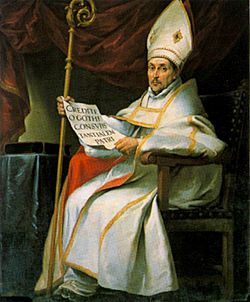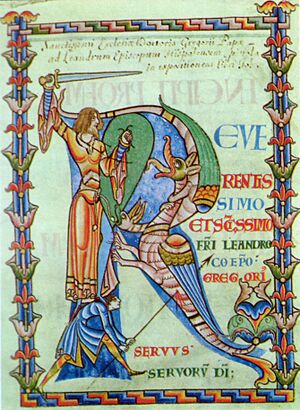Leander of Seville facts for kids
Quick facts for kids SaintLeander of Seville |
|
|---|---|

San Leandro by Bartolomé Esteban Perez Murillo
|
|
| Bishop and Confessor | |
| Born | c. 534 Cartagena, in modern Spain |
| Died | 13 March 600 or 601 Seville, Spain |
| Venerated in | |
| Feast |
|
| Attributes | episcopal attire |
Leander of Seville (Spanish: San Leandro de Sevilla; Latin: Sanctus Leandrus) was an important Bishop of Seville. He lived from about 534 AD to 600 or 601 AD. Leander helped the Visigothic kings Hermengild and Reccared become Catholic. His brother, Isidore of Seville, also became a bishop and was a famous writer.
Contents
Early Life and Family
Leander and his siblings came from a well-known Roman family in Hispania (modern-day Spain). Their father, Severianus, was a respected citizen of Cartagena. The family was strongly Catholic. At that time, many Roman people in Spain were Catholic. However, the Visigothic rulers and nobles followed a different Christian belief called Arianism.
Around 554, Leander's family moved to Seville. His siblings also became very important. Leander and Isidore both became bishops of Seville. Their sister, Florentina, became an abbess, leading many convents and nuns. Their third brother, Fulgentius, became the Bishop of Écija. All four siblings are considered saints in both the Catholic Church and the Eastern Orthodox Church.
Becoming a Bishop
Around 576, Leander became a Benedictine monk. In 579, he was chosen to be the Bishop of Seville. He also started a famous school. This school quickly became a center for Catholic learning.
As bishop, Leander met Ingunthis, a Catholic princess. She had come to Spain to marry Hermenegild, the son of the Visigothic king Liuvigild. Leander helped Ingunthis convince Hermenegild to become Catholic. This was a very important step, as it also had political meaning. Leander supported Hermenegild even when he went against his father, King Liuvigild.

Exile and Return
King Liuvigild exiled Leander when Hermenegild's rebellion failed. Leander went to Byzantium (the Eastern Roman Empire) from 579 to 582. He might have tried to get the Byzantine Emperor Tiberius II Constantine to fight against the Arian king. This attempt did not work.
While in Byzantium, Leander wrote books against Arianism. He also met Pope Gregory the Great, who was a representative for the Pope there. They became close friends and wrote letters to each other.
In 585, King Liuvigild had his son Hermenegild killed. Hermenegild is now considered a saint. King Liuvigild himself died in 589. It is not known exactly when Leander returned from exile. However, he played a part in converting Reccared, Liuvigild's next son and heir, to Catholicism. Leander continued to have influence over Reccared.
Fighting Arianism
Leander worked hard to strengthen the Catholic faith in Spain. He made sure that the Nicene Creed was recited during Mass. This helped people remember their faith against Arianism.
In 589, Leander called for the Third Council of Toledo. At this meeting, the Visigothic kingdom officially rejected Arianism and became Catholic. Leander gave a powerful speech at the end of the council. His brother Isidore later called it "a homily upon the triumph of the Church and the conversion of the Goths." After this council, Leander held another meeting in Seville. He never stopped working to remove the last parts of Arianism from Spain. His brother, Saint Isidore, continued this work after him.
Writings and Legacy
Only two of Leander's writings are still known today. One is a monastic rule for his sister, called De institutione virginum et contemptu mundi. The other is his famous speech from the Third Council of Toledo.
Saint Isidore wrote about his brother: "This man of gentle words and great talent shone brightly through his good deeds and his teachings. Because of his faith and passion, the Gothic people changed from Arianism to the Catholic faith."
The city of San Leandro in the US state of California is named after Saint Leander. His image and bishop's staff are shown on the crest of the Sevilla Fútbol Club.
Catholic and Eastern Orthodox Churches celebrate Saint Leander on February 27 and March 13. In Spain, his feast day is celebrated on November 13.
See also
 In Spanish: Leandro de Sevilla para niños
In Spanish: Leandro de Sevilla para niños
- List of Catholic saints
- Saint Leander of Seville, patron saint archive

